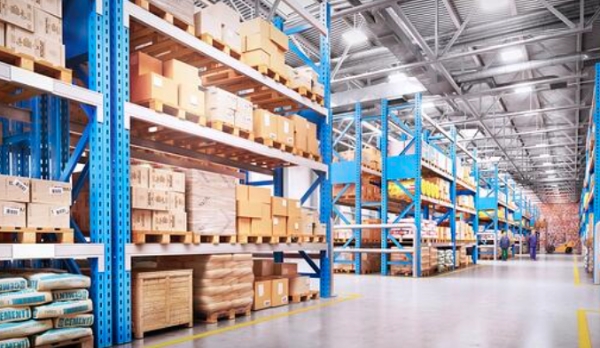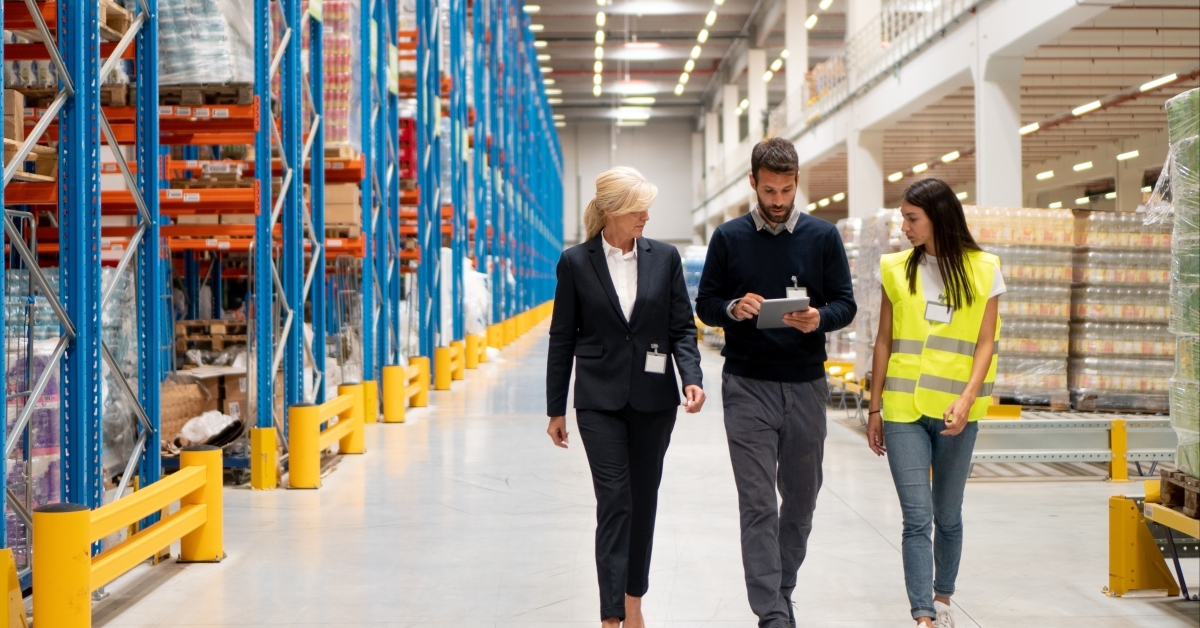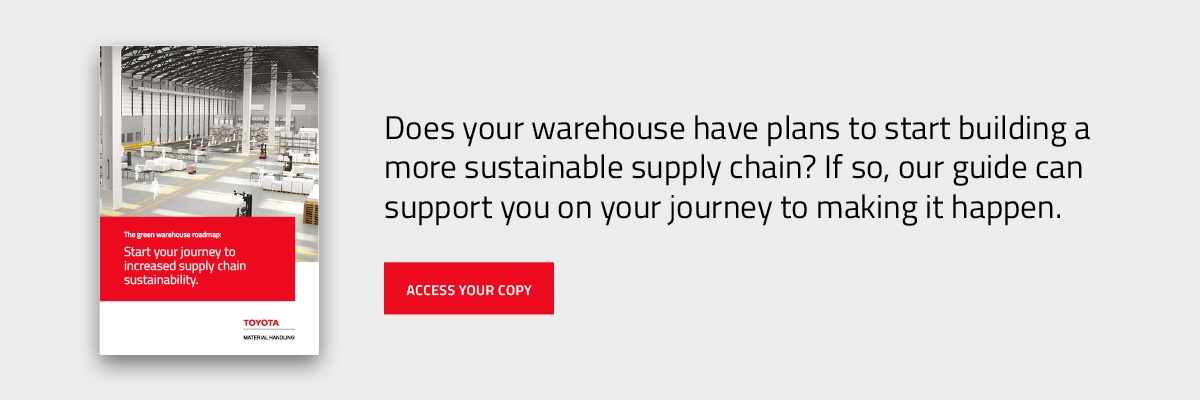Warehouse sustainability and efficiency are inextricably linked. The more efficient a warehouse is, the more environmental it is, using fewer energy and resources to create operational output.
This article explores the most impactful warehouse sustainability ideas and leaves you with a resource that will give you the confidence to implement them.
1. Install eco lighting.
Eco lighting is a warehouse sustainability idea we have highlighted in an earlier blog as a relatively quick way to reduce energy consumption. A concept extending to residential homes, eco lighting helps regulate energy consumption and even provides opportunities for automation, which we will discuss more in-depth later in the article.
LEDs have become the global leading lighting technology in large part because of their environmental benefits. Commercial eco lighting boasts the same brightness, ensuring safety at work while using much less energy than traditional or incandescent light bulbs.
2. Integrate renewable energy solutions.
Solutions such as solar panels provide warehouses with the opportunity to generate the energy they use to power their operation using natural resources. This can go hand in hand with using electric forklifts to power your fleet. Electric forklifts use batteries as opposed to combustion fuel and are therefore much more sustainable in the long run.
As well as being an effective way to cut operational costs, these types of solutions also reduce carbon usage and offer benefits to the natural environment.
3. Invest in insulation.
The third way to ensure operational efficiency is through proper building insulation. If a building can retain heat, it will use far less energy and avoid other unwanted problems such as mould and dampness caused by condensation.
Materials such as fibreglass can add a sufficient amount of insulation. However, cellulose, spray foam, wood and cork may be more eco-friendly options. Ultimately, you will need to consider a variety of factors when choosing which specific insulation material to choose, including your budget, typical weather conditions and if you need noise control, as well as the standard benefits of insulation.
4. Look to lean principles.
The godfather of warehouse sustainability ideas is Toyota’s Lean Principles, part of The Toyota Production System (TPS). By keeping lean principles in mind, you can assess waste and usage in every warehouse process, becoming astute at fine-tuning your operations to the environment.
Although less of a practice and more of a philosophy, lean principles help warehouse managers navigate green warehousing and work towards a sustainable future.
Build a sustainable operation with our guide.
Are you looking to discover the most effective strategies for building a green business and improving sustainability? Download a copy of our guide to get started.
5. Adopt automation.
Automation can feel like a controversial topic, especially regarding warehouses, since it is sometimes associated with job cuts. However, automation does the opposite in practice — it empowers warehouse employees to focus on more top-level tasks and work freely with less fear of human error or injury.
There are many types of warehouse automation, including Automated Guided Vehicles (AGVs) and goods-to-person technologies. Each can solve an array of warehouse problems, including increasing efficiency to create a more environmentally friendly workplace.
6. Reduce water waste.
Many warehouse sustainability ideas centre around utility reduction to create operational efficiency. Water is a basic utility that should be one of the first consumption areas to focus on.
Conserving water in the production process is one of the highest-impact strategies a warehouse can implement, alongside fitting standard water regulating equipment. Larger facilities can also explore the idea of water recycling, using a filtration system to reuse water in your own or another’s industrial processes.
7. Pick sustainable packaging.
There are many sustainable warehouse design ideas for logistics, including some simple switches such as selecting more environmentally friendly packaging. Depending on the function of your warehouse, this could make a big difference to the total carbon footprint of your business.
Sustainable packaging is a big talking point for the manufacturing sector, being raised as one of the expectations for warehouses across the country at the global climate change conference, Cop 26 in Glasgow.
8. Optimise waste management.
The importance of recycling is not news to anyone, but it cannot be underestimated in a warehouse sustainability strategy. Paying closer attention to waste management can foster an environmentally conscious culture and create real change in terms of how much warehouse waste goes to landfill.
In recent years, commercial and industrial waste produced in the UK has surpassed 40 million tons in a single year, sparking a need for more rigorous waste management systems. From creating clear signage to hiring a dedicated waste management supervisor, there are many ways to develop more stringent practices around the simple act of throwing your waste away.
9. Start a ‘reuse’ programme.
Waste management is not as elementary as putting the right items in the correct bins. Most flagship warehouses require further action, calling for innovation surrounding waste reuse. Finding a second life for excess materials, waste and defective products.
Reuse programmes can mean partnering with other manufacturers to find a scenario where your trash is quite literally another operation’s treasure. They can also be as innovative as creating an internal programme for waste reuse, such as a sustainable product line. In all their forms, reuse programmes are really beginning to pick up speed in this sector.
10. Opt for efficient equipment.
Just as we might choose a more environmentally efficient car or kitchen appliance, we are now seeing a shift to more efficient warehouse equipment. By investing in more efficient equipment, warehouses are future-proofing sustainable behaviour, allowing for energy-saving without requiring any conscious course of action.
If there is a more efficient version on offer, why not opt for it? Some good examples of efficient material handling equipment are fully-automatic shrink wrappers that are faster and only use the amount of material required to safely wrap a product, as well as pick and place machinery, such as Order Pickers, to increase production rates and decrease product wastage.
11. Revise warehouse layout.
The most efficient warehouses have a logical, well thought out layout that optimises available space and reduces workplace incidents. Warehouse layout is a topic people have studied in-depth, coming up with several optimal layouts, including U-shaped, I-shaped and L-shaped layouts as a result.
The key benefits of implementing a tried-and-tested warehouse layout are achieving faster production times and more efficient use of resources. All in all, helping you contribute to warehouse sustainability goals.
Get green warehouse ready with this roadmap.
There are many warehouse sustainability ideas warehouses can implement over time to create a more environmentally-friendly operation. However, there is an optimal way to implement each strategy, which we outline in our green warehouse roadmap.
From the order of adoption to specific things to consider, we make a green warehouse feel achievable for every operation by detailing all the ins and outs of the journey to a more sustainable operation.
Download your roadmap and start tackling warehouse sustainability step by step.

